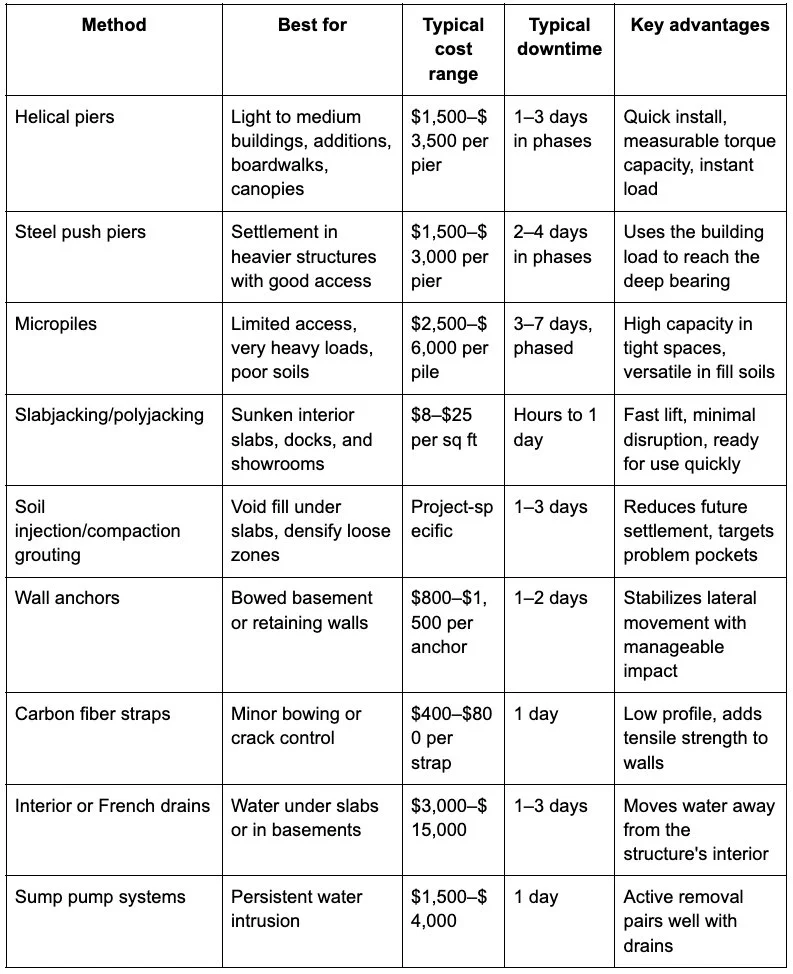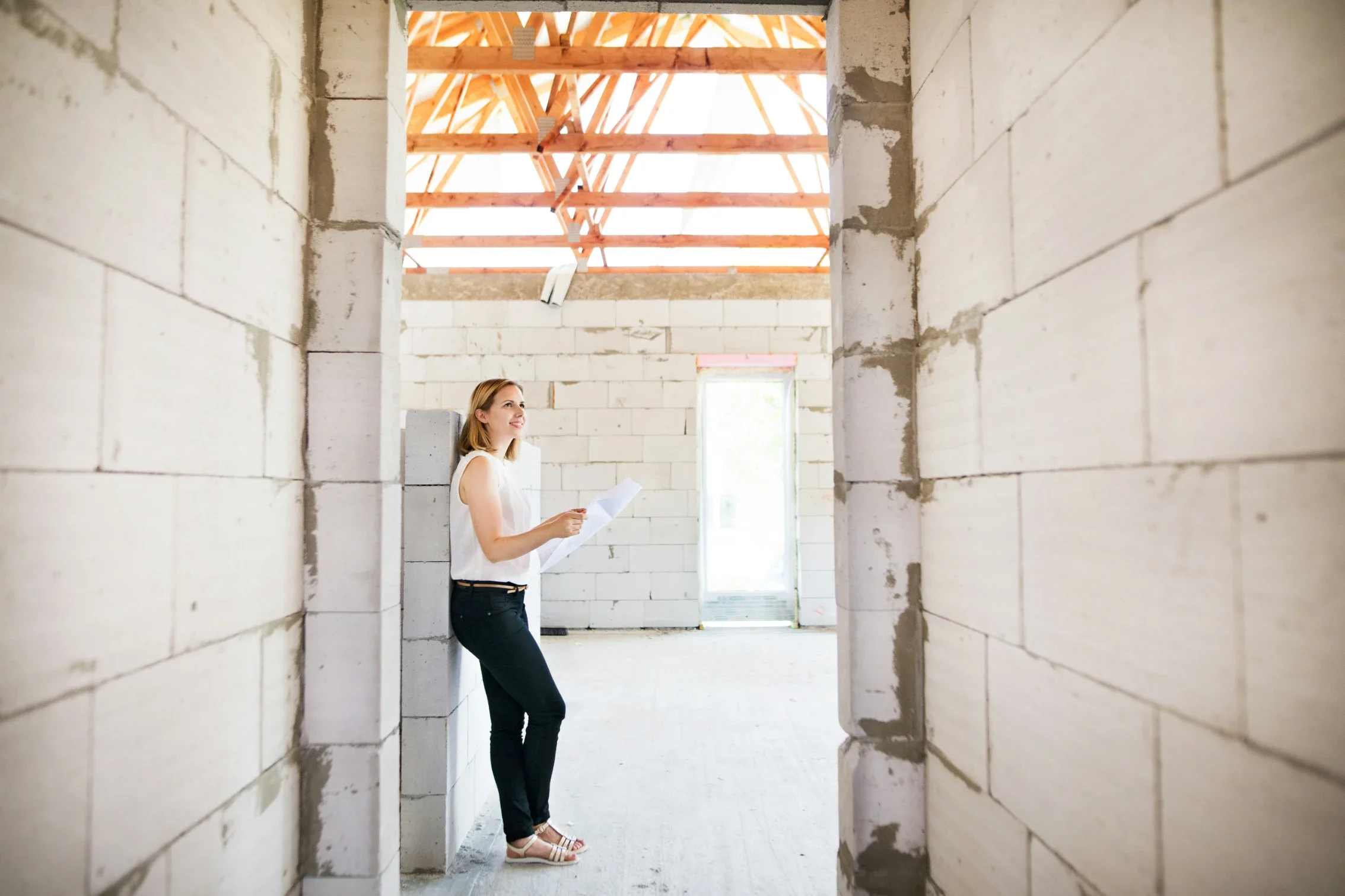Top Strategies for Commercial Foundation Repair to Protect Your Business Property
Protect your business property with proven commercial foundation repair strategies, including water control, helical piers, and proper soil management.
When a foundation shifts, your business can slow down or even stop. Doors stick. Floors tilt. Cracks grow. Safety risks rise. The fix is to act early and use proven methods. This guide from Two Bros Foundation Repair walks you through smart steps for lasting stability.
If you want a clear starting point, explore Commercial Foundation Repair to learn how to spot issues, plan repairs, and keep your site safe and open.
Spot Early Signs That Call for Commercial Foundation Repair
Small signs often come first. Catching them early saves money and time. Look inside, outside, and at the site around your building.
Interior red flags in business properties
New cracks at the door or window corners.
Doors that rub or fail to latch.
Gaps between floors and baseboards.
Loose tiles or buckled vinyl.
Uneven floors near heavy equipment or shelves.
Exterior clues on commercial sites
Stair-step cracks in brick or block.
Expansion joints that open wider in one area.
Tilted parapet walls or leaning signs.
Gaps where loading dock frames meet walls.
A chimney or façade pulling away.
Site and pavement indicators
Standing water near the slab after a normal rain.
Sunken sections in sidewalks or parking lots.
Soil pulled away from the foundation during long dry spells.
Repeated washouts near downspouts or scuppers.
If you see several signs at once, bring in a pro assessment fast. Early action protects people, stock, and equipment.
Build a Simple, Strong Plan With Business & Commercial Foundation Services
A clear plan starts with a baseline. Then you track changes and act with intent. Our Business & Commercial Foundation Services help you set that baseline and choose the right path.
Steps to create your plan
Walk-through: Note cracks, sticky doors, and floor dips.
Level survey: Use a digital level to map high and low spots.
Moisture review: Check gutters, downspouts, grading, and drains.
Load review: Find heavy zones like racking, tanks, or machinery.
Monitoring: Mark cracks with date stamps or use crack gauges.
With these steps, you can rank risks: water, soil, load, or structure. Then you select repairs that match the cause, not just the symptom.
Control Water and Soil To Protect Commercial Foundations
Water control is the top defense. Soil moves when it gets very wet or very dry. Clay swells and shrinks. Sand drains fast and can wash out. Your goal is steady moisture and clean water flow away from the building.
Fast water fixes that work
Clear gutters before storm seasons.
Extend downspouts 6 to 10 feet away from walls.
Regrade soil to slope one inch per foot for at least six feet.
Add splash blocks or surface drains at heavy roof discharge points.
Seal pavement cracks near the foundation to prevent infiltration.
Stable soil means a stable base. These simple steps reduce future repairs and keep operations smooth.
Choose the Right Commercial Foundation Repair Methods
Different problems need different tools. Below is a quick guide to common methods, where they fit, and what to expect. Costs are typical ranges and vary by site, access, and building size.
Note: Prices reflect typical commercial ranges, but every site is unique. Written scopes should include quantities, depths, torque or pressure readings, maps, and restoration details.
Helical piers for predictable lift
Helical piers screw into stable soil. Installers track torque to confirm capacity. They suit many commercial jobs because crews can phase work to limit shutdowns.
Steel push piers for deeper bearing
Push piers drive down to firm layers. They work well on heavier buildings. They can lift and hold settled areas with long-term stability.
Micropiles for tight or tough sites
Micropiles handle heavy loads in small spaces. They fit buildings with low headroom or tricky soils. They also work near existing utilities.
Slabjacking and polyjacking for fast floors
These methods lift sunken slabs by adding grout or foam under the concrete. They are great for warehouses and showrooms. Many floors can return to service the same day.
Soil injection for voids and soft spots
Compaction grouting fills voids and firms up loose soils. It does not always lift. It is best used with other repairs where soils have pockets or washouts.
Minimize Downtime and Keep People Safe
A good plan keeps your team and customers safe and your site moving. You can phase work to keep key areas open.
Steps that reduce disruption
Schedule by zone so the rest of the site stays active.
Protect aisles with barriers and clear signage.
Move stock or equipment from lift points ahead of time.
Use off-hours for loud or dusty tasks.
Keep a single site contact to coordinate daily changes.
Safety comes first. A tidy site, good barriers, and clear updates make a big difference.
Budget, Bids, and Contracts for Commercial Foundation Repair
Strong paperwork prevents surprises. Ask for details in writing and compare bids line by line.
What your proposal should include
Written scope with pier counts, depths, and locations.
Method statements for lifts and safety.
Water management plan: gutters, drains, and grading.
Surface restoration plans for paving, landscaping, or interiors.
Schedule with phases and target completion dates.
Warranty terms and what triggers service calls.
Typical budget tips
Get two to three detailed bids for major work.
Fund water control first since it protects future repairs.
Ask about phasing to spread costs across quarters.
Keep a small reserve for hidden conditions below slabs.
Clear bids lead to clear results. Pick the plan that solves the cause.
Case Studies: Low-Disruption Commercial Foundation Repair Wins
Case 1: Retail strip with ponding water and a door bind
Problem: Water pooling at the rear wall, two tenant doors stuck, back edge down about 0.5 inches.
Fix: Clean gutters, added downspout extensions, regraded soil, surface drain, six helical piers installed, and lifted.
Result: Doors worked smoothly, no more ponding, work finished in phases with stores open.
Case 2: Warehouse slab settlement at racking lanes
Problem: Slab dips near heavy racking caused product spills.
Fix: Mapped slab elevations, used polyjacking, sealed cracks.
Result: Smooth movement, reduced product loss, overnight work with no lost shifts.
Case 3: Historic office with fragile façade
Problem: Stair-step brick cracks, minimal vibration desired.
Fix: Helical pier plan, carbon fiber straps, repointed brick after structural work.
Result: Stable walls, clean finish, staff remained in building, historic features preserved.
Coordinate With Engineers and Inspectors
Large or complex sites often need a structural engineer. This adds clarity and protects your investment.
What to expect
Engineer review of soil and load paths.
Plans that set pier sizes, spacing, and lift targets.
Permit guidance and inspection sign-offs.
As-built records with readings and photos.
Keep these records with your property files. They help with future sales, financing, and insurance.
Maintenance After Commercial Foundation Repair
Repairs last longer with simple care. A small checklist keeps soil stable and water away.
Seasonal checklist for business sites
Clean gutters before the heavy rain season.
Verify downspout extensions are clear and in place.
Walk the site after storms for new ponding or erosion.
Seal new pavement cracks near the building.
Keep mulch and soil below wall vents and weep holes.
Track a few reference points on floors every quarter.
These habits support every repair method and reduce the risk of new movement.
Interior and Finish Repairs After Structural Work
Do not finish work after the structure is stable. This prevents rework and protects your budget.
Smart order of operations
Structure first: piers, anchors, or slab lifts.
Water next: drains, pumps, and grading.
Finishes last: paint, tile, doors, and caulk.
This simple order leads to durable results and a clean look.
Communication Plan for Multi-Tenant Sites
When tenants know what is coming, everyone wins. Clear updates prevent stress and keep operations steady.
Keep tenants in the loop
Share a short weekly schedule with affected areas.
Mark safe routes and staging zones on a simple map.
Give a single contact for questions.
Set quiet hours for office areas if possible.
Good communication keeps the project on track.
Why Two Bros Foundation Repair for Commercial Projects
Your business needs speed, clarity, and safety. Two Bros Foundation Repair delivers all three with a focus on results.
What we bring to your site
Clear assessments with level maps and photos.
Phased schedules to limit downtime.
Proven methods like helical piers, micropiles, and slab lifts.
Water control plans that protect your investment.
Detailed warranties and service support.
If you want a direct path to stability, start with Commercial Foundation Repair. We tailor plans to your building, soil, and budget.
FAQs on Commercial Foundation Repair
How fast can work start? After assessment and permits, many projects start within days. Phasing helps you stay open.
Will repairs fix all cracks? Repairs stop movement. Some cracks close; others need patching or repointing.
Do we need to close the building? Not always. Many jobs run in zones, nights, or weekends with safety controls.
How long do piers last? Properly installed piers and micropiles are designed for decades.
What about heavy equipment areas? We review loads, wheel paths, and slab thickness. Slabjacking, soil injection, or added supports may be used.
Conclusion
Strong foundations protect people, inventory, and cash flow. Start with early signs, fix water control, and choose structural methods that match the cause. Plan work in phases, keep clear records, and finish last. This simple path cuts downtime and risk.
Two Bros Foundation Repair is ready to help you assess, plan, and deliver the right fix. For a deeper overview and a tailored plan, explore our Commercial Foundation Repair and learn how our Business & Commercial Foundation Services can support your site from first visit to final sign-off.





